Japanese beetle traps are safe, non-toxic, and very effective at capturing these nasty pests. But are they worth it?
In this post, you’ll learn all about using them, including the pros and cons, how they work, when to put them out, where and how to hang them, and what to do with the dead bugs.
I will answer all of your questions, and give you the information you need so you can decide if Japanese beetle traps are right for you.
How Do Japanese Beetle Traps Work?
Japanese beetle traps come with bait that lures them in. The bait is made with pheromones (a natural sex attractant), as well as floral scents that the Japanese beetles (JBs) can’t resist.
Once they fly to the lure, they will fall into the trap and can’t get back out. It’s actually kinda funny that they can’t find their way back out because the traps are wide open on top. But I guess JBs aren’t very smart.
Related Post: How To Control Japanese Beetles Organically
How To Use Japanese Beetle Traps
It’s super easy to use JB traps, so you’ll probably find set up and assembly pretty self-explanatory.
Of course you should always follow the instructions on the package that yours comes in. But here are my tips for using them from experience…
When To Put Them Out
It’s best to put out Japanese beetle traps just before the adults start emerging in mid-summer, or once you spot the first one in your garden.
As for time of day… I definitely recommend putting them out either at night or very early in the morning when the beetles aren’t active. Also, I highly recommend waiting to open the attractant until the very last step.
Opening the attractant is the first step in the instructions, but don’t do it. Instead, get everything assembled and hang the trap before you open the bait packet.
The lure attracts the JBs immediately, and they’ll start flying in from all directions as soon as you open it.
They don’t bite or sting, but having a bunch of bugs buzzing around and crawling on you while you’re assembling and hanging the trap might not be a very fun experience. EEK!
How To Set Up The Trap
The exact steps for assembling your Japanese beetle trap will depend on the type that you bought. So be sure to follow the setup instructions on the package.
The kit I have came with a reusable top that has slots to hold the attractant, as well as a lure, a tie for hanging, and replaceable bags.
So, all I had to do was attach the bag, tie, and attractant to the top part, and I was good to go.
How To Hang Them
My kit came with a long twist tie to use for hanging. If yours didn’t come with one, then you could use cut-a-size garden ties, wire, or string to hang yours.
The empty bags blow around a lot in the wind, so be sure to use a sturdy tie to hang them.
As for what to hang them from… well you’ll want to find a place where there’s plenty of room around the trap because the Japanese beetles will fly in from all directions.
I hung mine from a plant hook that sticks out about a foot from my porch. But you could use a shepherds hook, or buy a stand to hang it from.
Where To Place Them
The key to success with a Japanese beetle pheromone trap is to hang it in an area of the yard as far away from their favorite plants as possible. If you put it right in your garden, it will attract more beetles to the plants.
Of course the joke is that the best place to hang the traps is in your neighbors yard. But that’s probably not going to be an option for most of us. Haha!
So find a spot that’s on the other side of the yard from the infested plants. I hung mine from my porch, which means I can watch it from inside the house (morbid curiosity).
Once you have the trap set up, be sure to check it daily to see how full it is. They can fill up fast, and the dead beetles get pretty stinky after a few days, so you should empty it frequently.
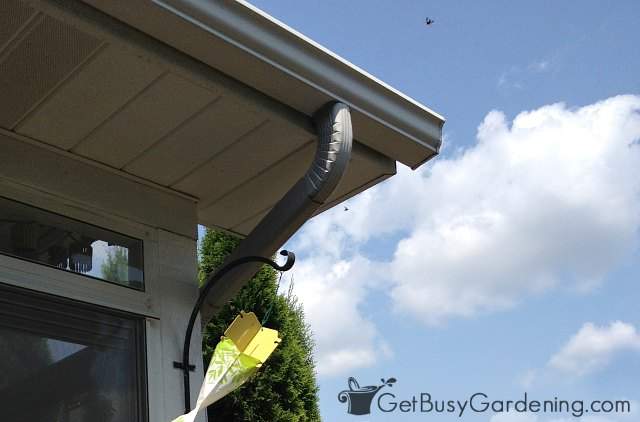
How To Dispose Of Full Japanese Beetle Traps
If your trap has disposable bags like mine, then you can keep the top and attractant in place, and just replace the bags when they’re full – easy peasy. But again, be sure to do it early in the morning or at night when the beetles aren’t active.
The replacement bags are inexpensive, and make it simple to get rid of the dead beetles. But some types of traps are disposable, so you can just throw the whole thing out once it’s full.
To dispose of the dead Japanese beetles, simply tie the bag shut at the narrow center (I use twist ties to do that). Then you can throw the whole thing into the trash.
Do Traps Attract More Japanese Beetles?
Yes, the traps absolutely attract Japanese beetles – but that is the whole point. It’s also why you should place them far away from your garden.
When I heard the traps would attract WAY more (like THOUSANDS more) of these destructive pests to my yard it scared me at first.
But I have the biggest gardens in my neighborhood, so I’m pretty sure that I already have one of the largest populations of JBs too.
I figured that if I’m killing a few extra hundred of them in the traps every summer – well, that’s less of them that can reproduce in the neighborhood.
My Experience
There have been years where I’ve used Japanese beetle traps in my yard, and also several years where I haven’t.
I’ve never noticed a larger amount of them on my plants in the years that I used the traps (and I’ve certainly never seen thousands more of them).
So I personally don’t feel that the claim of the traps attracting large hoards of JBs to my yard is true. But your experience may be different.
Should You Use Japanese Beetle Traps?
Ultimately, this is a question you need to answer for yourself. You should weigh all the pros and cons before deciding if they’re right for you.
If there are only a handful of Japanese beetles in your garden, then I would not bother with using the traps.
However, if you have a large population of them like I do, and your yard is big enough to place the traps away from your garden, then it’s worth a try.
Remember, the purpose of the traps is to attract Japanese beetles. So that means that more will be coming to your yard. But, they also capture and kill TONS of JBs too, which means you’re taking them out of circulation.
FAQs
The attractant lure is made with a natural Japanese beetle sex pheromone, as well as flower scents that they love.
If you buy reusable traps, the bait should last all season long. Discard it in the fall, and buy a replacement lure each spring.
Yes, the traps definitely work to attract and capture Japanese beetles, and you will get a LOT of them in the bag. After flying into the trap, they will eventually die.
In this post, I’ve given you all the details, including the pros and cons of Japanese beetle traps. They’re easy to use, and non-toxic. But they also attract JBs to your yard. So in the end, you need to decide if they’re right for you.
Share your experience with using Japanese beetle traps in the comments section below. Would you recommend them or not?


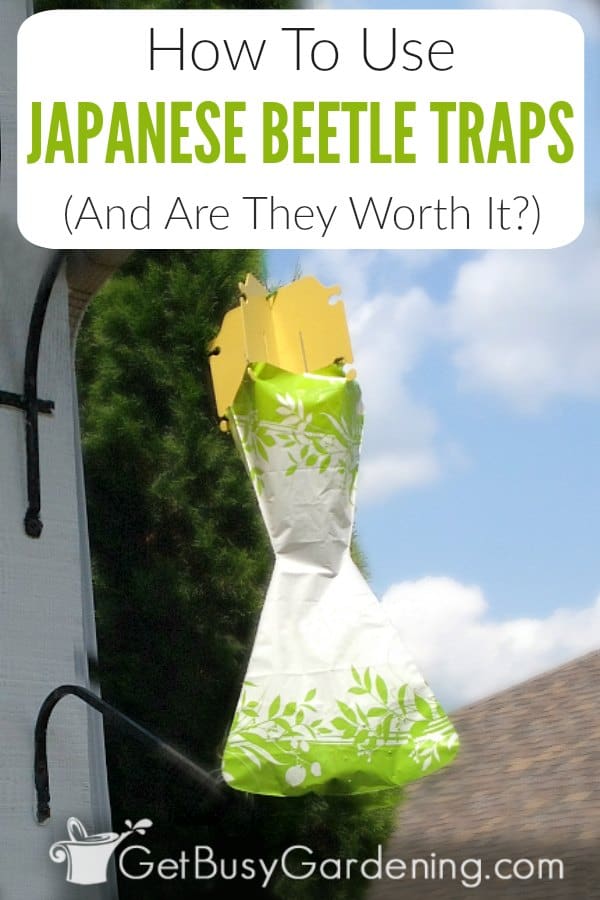
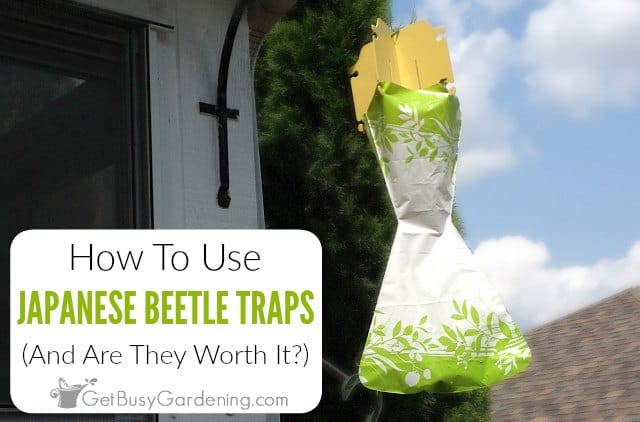

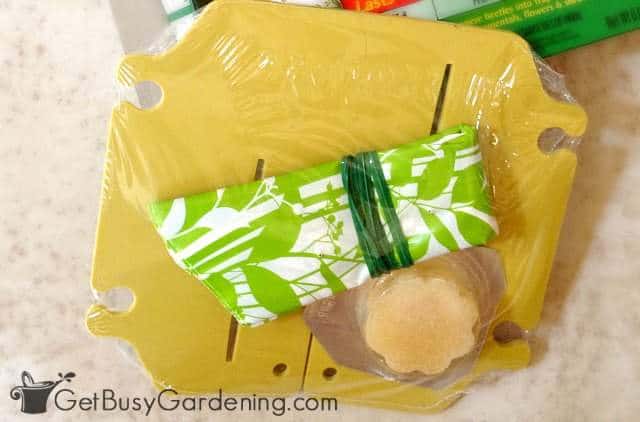
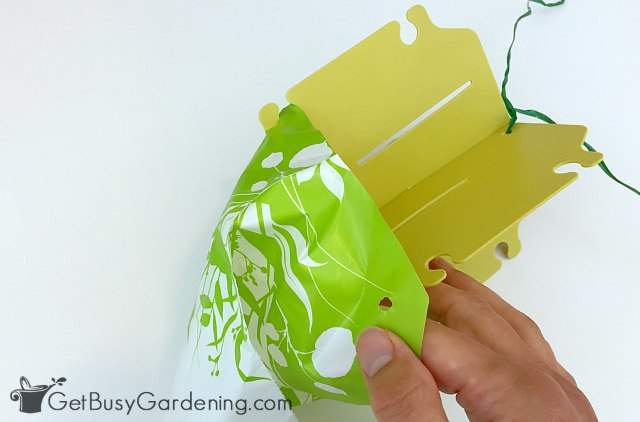
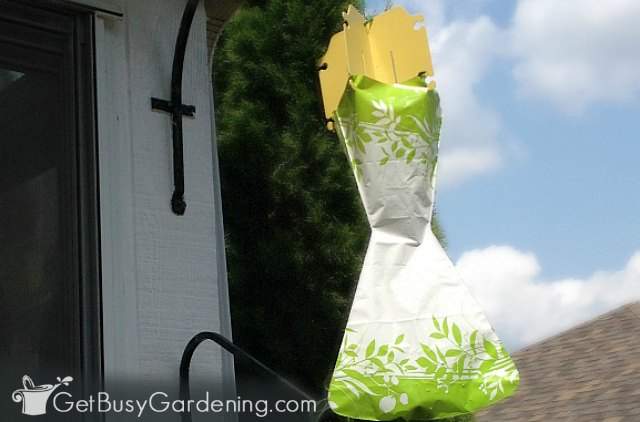

Claire Ditzel says
I have been using the traps several years now. I have 5 acres of prairie grass and garden. This year I will be dumping one bag into my chicken run so they can feast on them each evening. They work great and last year I had a bear tearing one bag open and feasting on the dead bugs.
Amy Andrychowicz says
Awesome, thanks for sharing your success with using JB traps! It’s great to hear that other animals enjoy eating the dead bugs, makes for an easy meal for them! 🙂
Donna Stewart says
Well my bag has a zipper on the bottom to let them out. How long does it take for them to die I don’t want to let live one’s back out.
Amy Andrychowicz says
Good question. I don’t think it takes more than a few hours for the Japanese beetles to die inside of the trap, especially when it’s sitting in the hot sun. If I were you, right before I go to bed each night, I would dump the zipper bottom bag into a plastic bag that I could seal shut. Otherwise, I would switch to the disposable bags – because in all honesty, I’m too squeamish to empty the bag of dead beetles! LOL!
Nancy says
I just emptied my trap for the first time because it filled up quick. I noticed a lot of the beetles were still alive. How long does it take for them to die? It is sitting the sun.Should I have emptied it into a bucket of soapy?
Amy Andrychowicz says
The best way to dispose of Japanese beetle traps is to discard the whole bag, rather than dumping it out. I seal the top with a twist tie or string so the beetles can’t escape and toss the whole bag into the trash. Otherwise it will just keep filling up with new beetles, and there will always be live ones in there.
Raymond says
Does this traps work better if you use 2 lures at a time instead of just 1?
Amy Andrychowicz says
Using more than one trap in your yard will definitely attract more Japanese beetles than just one. But if you mean using two lures in one trap, then that would be wasteful. One lure per trap is plenty strong enough.
Jax A. says
I bought a japanese beetle trap because my garden has been completely dominated by them. Let me tell you, my trap was completely full of JB’s in about 3 hours. I absolutely hate insects, but this is the only JB method that has worked for me. I usually change the bag in the rain or in the early morning when I go to work. I’m going to keep using the traps for the season, but I have to contemplate if I can tolerate the beetles long enough to change the bag.
Amy Andrychowicz says
Glad to hear the Japanese beetle traps are working so well for you! You can also change the bag in the late evening, after the beetles have settled down for the night. Changing the bag is definitely the worst part, but at least you know it’s working. 🙂
D. Davis says
Commercial Japanese beetle traps have rather small openings. In
their meandering, wandering flight, beetles approaching the pheromone lure
often miss the trap vanes and fail to be caught. I have devised a simple
way to improve the trapping rate greatly. Put 3/4 inch of soapy water
into a 5-gallon plastic bucket. Lift the bucket around the trap, so the
bucket rim overlaps the lower part of the trap vanes, and hook the bail
over the same attachment that holds the trap. (If your trap has a long
bag, you may need to fold the bottom of the bag up and attach it to the
higher part with bag clips or clothespins, so the bag doesn’t touch the
water.) This makes a much wider target, and many beetles that would
otherwise fall past the trap fall into the water. I find that this easy
enhancement about doubles the capture rate.
This method would probably work just as well if the trap bags are
dispensed with altogether, leaving only the bucket, trap vanes and lure.
The vanes are desirable because the incoming beetles tend to hit them,
disrupting their flight and making them fall downward. It matters little
whether they end up in a bag or in soapy water, but the water kills them
more quickly.
Amy Andrychowicz says
That is a fantastic tip!! Thank you so much for sharing your homemade Japanese beetle trap with us!
Pete says
Pour the dead beetles from the bag into a bucket with water and dish soap. Then reuse the bag over and over. Just dump them each night as some animals may chew through the bag.
Frank says
I have had issues with raccoons ripping the bags open at night ( I guess they eat the beetles ?). Had to hang them from the middle of a clothesline strung across two trees
Amy Andrychowicz says
Ugh, gross!! Yes, raccoons are scavengers, and probably attracted to the smell of the dead Japanese beetles in the bag. YUCK!
Jill Donaldson says
Has anyone ever used these beetle traps inside. The reason that I am asking is that I live in a converted barn surrounded by forest and crop fields and the little darlings are entering through crevices in the walls. Any suggestions to get rid of these pests would be greatly appreciated.
Amy Andrychowicz says
Yuck, sounds terrible! No, I’ve never had this issue. I’ve never heard of them getting inside like this, are you sure they are Japanese beetles and not the Asian Lady Beetle (often mistaken for ladybugs)? Japanese beetles have a pretty short lifecycle, and they hibernate in the ground. Asian lady beetles will cluster on buildings and find their way inside to hibernate. Japanese beetle traps will not work for Asian lady beetles. Whatever it is, hopefully you’ll get it under control.
CrazyAnn says
I used JB traps last year and killed at least half a million. No, that is not an exaggeration in any way. I had the big tanglefoot traps and emptied them sometimes 3 a day. But the trouble is…..you are pulling them in from up to 3 miles away. Yep, 3 miles.
So this year I did not choose to reuse my traps and spent most of the summer hand picking. I will not be using the traps again.
Amy Andrychowicz says
Thanks so much for sharing your experience! It's so awful how many beetles you had come to your yard and traps! I can't believe how out of control this pest has become.
The beetles have gotten exponentially worse for me over the years. But they didn't seem any worse after putting the trap in my yard, so I still feel ok about it.
Susan in Eagan says
I'm thrilled the geranium worked its magic! WOW is right! I haven't planted the rest of mine yet–they're still on the deck getting dried out–but now I will tomorrow for sure.
Also, I read somewhere that you aren't supposed to squish the darned things because they release pheromones that call out to other beetles to come.
And guess what? I found two beetles on my green beans tonight. Sigh.
Amy Andrychowicz says
I'm keeping my geranium in a pot on the deck, that way I can see and kill the ones that are paralyzed easier.
Oh no, sorry to hear the Japanese beetles have discovered the green beans! They also love to eat my canna lilies, sunflowers and zinnias. Ugh, where will they show up next?
Susan in Eagan says
Yes, I covered two of our grapevines (third one is way too big) last year, but haven't gotten around to it yet this year (remember the green curtains from G'will?). I've had no beetles on the beans that I know of. Isn't that strange? They're pole beans–are yours bush?
Amy Andrychowicz says
Covering our grapevines to protect them from Japanese beetles has worked great for us. I know what you mean though, summer is always so busy! It is funny that the beetles haven't bothered your beans (mine are pole too). My neighbor said the same thing. Ours are so infested that I'm thinking we're not going to get a very good crop of beans this year. Weird!
Hey, BTW, I saw two beetles laying upside down under the geraniums today!! WOW! After I saw the first one, I thought it might just have been a coincidence, but then there was another one. Only one ended up in the water, and I squashed the other one. I can’t wait to see how many more I get this way. So cool! Thanks again for sharing that tip!
Susan in Eagan says
The bowl of water is a great idea! Let's keep our fingers crossed. (I murdered another hundred or so beasties yesterday on my rounds from grapevines to roses to grapevines; even found some on the daylilies.)
Amy Andrychowicz says
Yes, my fingers are crossed. I will be checking my geraniums often. I think I killed about 1,000 yesterday. The trap was full, and I got at least a couple hundred in my bucket. Gosh, they are so disgusting! They love the roses and beans the most in my yard.
I actually cover our grapevines. They don't need bees for pollination, and I know the Japanese beetles (and birds) LOVE them. Here's a post I wrote about how I do that… How to Protect Grapes from Birds and Bugs.
Susan in Eagan says
Erin, have you noticed fewer beetles chewing on your plants since you started using the bag traps? I'm really tempted to try it, but Bachman's tells me it will attract JBs from two or three football fields' lengths away, and that's scary!
I'm trying geraniums–have you heard about that? I found one paralyzed JB nestled in a blossom today, so that's a good sign.
Amy Andrychowicz says
I know, it really does sounds scary. For me, it seemed like there were less in my bucket after the first few days of setting the trap. But now that we've been out of town for a few days, the JBs were all over the roses and beans tonight. I can't believe how many were in our bucket. But, the trap was pretty full. I meant to take it down while we were gone, but forgot. I will get back on my schedule of going out nightly to hand pick them, and see if there are less after a few days.
I haven’t heard of the geraniums. Do all types of geraniums kill them, or is it just a certain type?
Susan in Eagan says
The little bit of research I've done refers to them as "common geraniums," and I've run into a couple sites that say white ones are better than colored.
I'm not seeing paralyzed JBs at the base of the plants so far, but it's easy to pop a few geraniums in the ground, so I'll wait awhile before declaring this a success or a failure. (I've never liked geraniums before, but they’re starting to look nice to me!)
Susan in Eagan says
I just wanted to add that the geraniums don't kill Japanese beetles, they just paralyze them and leave them prey for birds to pick off (for up to 24 hours, supposedly).
Amy Andrychowicz says
Wow, this is great information. Thanks for clarifying about the paralysis and not death. The paralyzed Japanese beetles would also be easy to pick up and drop into a bucket of water or step on. I've never heard of using geraniums before so thank you for sharing! I can't wait to hear if you have success with this or not.
Susan in Eagan says
Two Japanese beetles found paralyzed on geraniums today! Two isn't much–I had expected lots more–but I was pleased to see the paralysis actually happened–we'll see what transpires in the long run. Maybe they just haven't found the plants yet (eternal optimist).
Amy Andrychowicz says
Yes, that is awesome! I went out and bought three geraniums. I'm going to put them in a pot right under the trap. I'm going to put a bowl of water under the pot so the Japanese beetles will drown when they drop. Can't wait to see if it works!
Lynn says
I had not much of a problem until I put out Japanese beetle traps. We have 25 acres so I was able to place the traps a long distance from my plants. I wish I’d never used the traps because now I have an enormous problem. Thousands every year! It is so disheartening to see my beautiful garden devoured every year!
Amy Andrychowicz says
Interesting. It might be that the Japanese beetle population hadn’t exploded in your area yet. The first few years I saw them in my garden, I only saw maybe five or ten of them all summer. It took about 5 years before their population exploded here in MN, and now they are everywhere. I never used traps until after the population spiked.
Erin says
I've done both hand-picking, spraying and the bags. The bags WILL draw 1000s more to your yard, but that's 1000s you are taking out of circulation. I don't want to spray chemicals all over everything, especially since the one bush they love is the same bush my hummingbirds visit. I can't keep up with hand-picking because I'm at work during the most active part of the day and the beetles are now higher than I can reach on this one bush they love. So, I trap them. I did buy the Tanglefoot reusable JB trap, which you can use for years. Just untwist and dump the beetles in a used grocery bag, tie off and dispose. It’s super simple to use.
It’s hard to know which is the right course of action. I can’t stand seeing Japanese beetles in my garden. I can only hope I’m making the right choice. We’ve trapped 1000s of beetles so far this season.
Amy Andrychowicz says
Erin, I totally agree with you. And I wish some of my neighbors would put up the traps too and help kill even more beetles. I'm too squeamish to dump out a trap, I like to be able to just twist tie it shut and throw it away. 🙂
My beans are taking the worst hit this year. Last year, they were prolific even with the beetles feasting on them. But this year, they aren’t doing very well. My roses look terrible too. Tonight there must have been 20 beetles on each flower. Ugh, it’s awful!
PlantPostings says
I heard the same advice about the traps attracting more Japanese beetles. I guess your course of action makes sense–if you have the biggest infestation in the neighborhood anyway. I saw my first Japanese beetle yesterday. Ours haven't been too bad, but maybe it's because we've had less than an inch of rain since mid-May! Not a fun year for my garden.
Amy Andrychowicz says
Yes, that is certainly something to consider. I can't believe how many I've been catching with the trap. But it's so satisfying to see all those dead Japanese beetles that would have otherwise reproduced thousands more. Ugh, what a terrible pest. Sorry to hear about your drought, hope you’ll get some rain soon!
Susan in Eagan says
I've always read/been told NOT to use the traps because they attract more Japanese beetles, but our yard is fairly big, and I could put them at the perimeter. It's so disheartening to see them devouring everything. I've been catching dozens every day.
Amy Andrychowicz says
Yes, it is so disheartening! I've been trapping hundreds of Japanese beetles every day in mine lately! We went away for a few days, and I forgot to take the trap down. There must have been 1000 in there today! Plus we must have caught another 200 in our bucket tonight. Wow!
Julie says
Thank you for this very helpful post. I had a horrible infestation last summer that killed major sections of my lawn. I used a Grub-Ex type product this year to kill the larva but like you said, pesticides will kill the good with the bad insects and the cost also adds up fast to treat large lawns. I hadn't heard of these traps so now I am off to the store to get a bunch! I'll keep you posted!
Amy Andrychowicz says
You're welcome! Good luck with the traps, and let me know how it goes for you. I emptied my trap last night because it was over 1/4 full! There had to be a couple hundred beetles in there in just ONE DAY!!! Can you believe it! Disgusting!